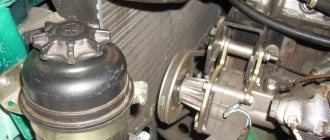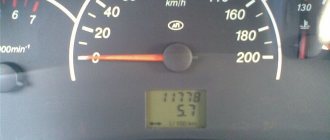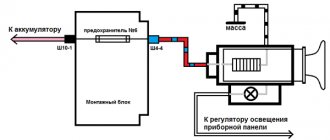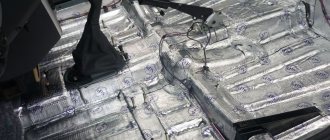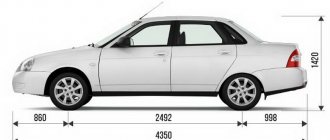The tank volume of the Priora car “inherited” from its predecessors - 43 liters. How many years have passed, the VAZ-2108 was equipped with a gas tank of the same volume, the same was installed in the VAZ-2110, and after the VAZ-2110 was removed from the assembly line, and after the launch of production of the Lada Priora, the number of liters did not change! However, the fuel tank of a Priora car (sedan, hatchback and station wagon) has its own article number (catalog number) - it is the same on all three bodies. Priora should not despair: this fuel tank volume is considered the most optimal, for which there is a simple explanation:
Priora is a city car with low consumption on the highway and average consumption in the city. In the city, it is easy for a motorist to find a gas station, fill the tank regularly; on the highway, it is easy to calculate the distance to the nearest gas station, and then refuel on time. The volume (capacity) of the tank on the Priora is ideal for the operating conditions for which it is intended.
Lada Priora with a tank volume of 43 liters was produced from 2007 to 2013 - there were no changes. The volume does not depend on the body - be it a sedan, hatchback, station wagon or coupe - or on the configuration. The tank capacity on the Priora is designed to allow you to get from point A to point B within the city, sometimes stopping at a gas station. The number of liters, of course, can be called “untrue”: curious Prior owners found out that the car is literally filled “to the brim” with 49 liters of gasoline.
Story
The fuel tank of the Lada Priora was inherited from its predecessors, such as the VAZ 2110. The volume of the fuel tank in the Priora is almost 43 liters. This volume was considered by AvtoVAZ engineers to be proportional to the engine volume, because back in the 80s, a gas tank of exactly the same volume was installed on the VAZ 2108. How much time has passed since those years, and the volume of the tank has not changed.
After the completion of production of the VAZ 2110 in 2007, the fuel tank was completely pumped by the then newest car of the Volga plant - Priora. It should be noted that the fuel tank was not completely copied from the VAZ 2110, but still has some bug fixes.
For example, in a VAZ 2110, the fuel pump glass was fastened with nuts to studs with a diameter of 5 mm, which, after several processes of removing and installing the glass, simply left these studs in a terrible state. In the best case, the threads on the studs were licked off, and in the worst case, when tightening, the stud was completely torn off from the tank.
In Priora, this problem was solved by installing new studs with a larger diameter, namely 6mm. This modification greatly strengthened the fixation of the fuel pump and increased the tightness of the fuel tank.
VAZ 2170 | Fuel tank
The fuel tank of the Audi 80 is technically quite advanced, but it has also been improved for all-wheel drive models. The complex shape of the fuel tank helps achieve a large tank capacity without sacrificing luggage compartment volume. In the middle of the fuel tank you can see the fuel pump and fuel quantity indicator sensor. At the top right is the filling pipe with all the ventilation and filling hoses.
Rear right wheel arch with fender liner removed
The fuel tank in front-wheel drive Audi 80 models has a capacity of about 66 liters; in all-wheel drive versions it holds a minimum of 64 liters. To achieve a flat surface on the bottom of the luggage compartment with the possibility of loading the passenger compartment, the fuel tank is installed in the rear of the car under the sheet bottom of the luggage compartment. The tank itself is made of plastic - a material that allows almost unlimited possibilities when shaping. These opportunities were used one hundred percent. For example, the fuel tank of all-wheel drive models occupies almost all the free space under the body, which is done in order to achieve the largest possible volume. Therefore, the shape of this car part looks rather strange. To ensure that parts of the fuel tank located below are also emptied during the trip, a clever trick was used: in this lower area there is a pump that, when the engine is running, constantly pumps fuel to the parts of the fuel tank located above. Moreover, this happens quite simply: the return fuel from the fuel return line picks up additional fuel in the pump housing and carries it upward.
Another trick was used to deal with chambers of different volumes in the fuel tank: a hose is connected to the filler pipe leading directly to the suction area, so that it fills first. This is important, for example, when adding a small amount of fuel from a spare canister.
Tip: Before you start working on the fuel system, you must always disconnect the ground cable from the battery. Unintentional electrical shorts can cause dangerous sparks.
Why is fuel tank ventilation needed?
- Ventilation of the fuel tank is important for uninterrupted fuel supply: in the same quantity as the fuel consumed, air must enter the tank, otherwise a reduced pressure will form in the fuel tank and the flow of fuel will stop.
- The fuel tank must be ventilated to allow the contents to expand when heated.
- When refueling, it is necessary that air can escape from the tank, because otherwise the poured fuel will rise again to the filler pipe and begin to pour out.
Ventilation of the fuel tank in the Audi 80
- The fuel tank ventilation pipe is connected directly behind the filler pipe. The ventilation duct leads first to the so-called gravity valve. The latter closes the pipeline as soon as the car tilts to the side by more than 45°. This prevents fuel leakage through the ventilation ducts during an accident. After passing through the air valve, the ventilation line does not lead directly to the outside, however, but ends in the activated carbon reservoir in the front right wheel arch. Its purpose is to catch fuel vapors passing through this pipeline (arising, for example, as a result of heating the contents of the fuel tank). When the engine is running, these gases are again sucked out of the activated carbon tank at a certain engine load. When this should happen is determined by a load-dependent solenoid valve.
- In parallel to this system, the air valve opens the expansion tank of the fuel tank during refueling, located in the filling channel (in the right rear wheel arch) in the form of a separate container. Thus, with increasing fuel levels, fuel vapors can be displaced there instead of escaping into the atmosphere.
- While driving along this path, outside air enters depending on the amount of fuel consumed, so that a vacuum does not form in the tank.
Why 43 liters?
Sometimes people have the question, “Why only 43 liters?”, because many foreign cars with the same engine capacity are equipped with a much larger fuel tank. The answer to this question can be summarized into several points.
Priora is a universal car with a small engine capacity. As you know, the smaller the engine volume, the lower its consumption. Also, Priora is most often equipped with a manual transmission, which also makes its consumption much lower than that of foreign cars with an automatic transmission.
Priora has average fuel consumption in the urban operating cycle and fairly low consumption when operating on the highway. In the city it is quite easy to find a gas station and top up fuel if its availability has crossed the minimum mark. As for the route, the Priore is more than enough for this fuel tank capacity to cover long distances. The average consumption of the Priora on the highway is from 5 to 6 liters when driving in 5th gear and at a speed of 100 km/h.
By the way, the volume of the tank is exactly 43 liters, but if you fill the fuel to the very neck, then almost 48 liters of fuel will fit into the Priora. This is explained by the rather long filler neck, which holds almost 5 liters of fuel.
how many liters is the gas tank of a Priora station wagon?
Hello everyone, on October 31 I became the owner of a Priora station wagon. I bought it at Hermes-Lada. Overall, I liked the car, but there were some small flaws, for example, on the “fourteenth” there was an on-board computer and you could see how many liters of gasoline were left in the tank. Nominal refueling volumes of the Lada Priora VAZ 2170 car. Refueling location. Fuel tank System engine lubrication Engine cooling and interior heating systems Gearbox Hydraulic brakes Windshield washer reservoir. The volume of the fuel tank is 43 liters. VAZ News. The luxury version of the LADA Largus station wagon and the LADA Largus Cross have acquired parking sensors. The new Lada Kalina family has officially gone on sale. A week ago, having arrived at a gas station with about 10 liters in the gas tank, I decided to reliably find out how much is included “with a slide”, i.e. There is one. When I calibrated my tank, 45 liters fit. Filled it up to the neck. Vdm113Moscow. From stall to full tank it takes about 47 liters. Table 1 shows the volume of the fuel tank, how many liters the LAD tanks hold, for the following car models: LADA Kalina, LADA Kalina hatchback, LADA Kalina station wagon, LADA Kalina sedan, LADA Granta, LADA Priora, LADA Largus, LADA 213100. Review of the LADA Priora car Universal.
The front-wheel drive passenger station wagon LADA Priora (VAZ 2171) is one of the popular models of the Tolyatinsk automobile plant. When filled to the ceiling, the volume of transported cargo reaches 1200 liters. Interior. The Priora's gas tank holds 43 liters of fuel. When the fuel shortage light comes on, there are 6-8 liters left in the tank. But it’s better not to let it get to this point; if the injector is standing, it will start to grab dirt and clog the injectors. On my Lada Priora the tank is 43 liters. Consumption on the highway ranges from 5 to 7 liters. Granta sedan liftback Sport version Kalina hatchback station wagon Cross Sport version Priora sedan Vesta sedan CNG XRAY crossover Largus station wagon Cross van 4×4 3 doors. I wonder how much can fit in the gas tank and pipe when refueling “as far as I know, if the tank contains less than 2 liters, it’s not realistic to drive))).
2108->2112->21114->Priora station wagon->Duster. What is the volume and how many liters of the tank on the VAZ-2112. The minimum level is 10 liters. The sensor will certainly light up as soon as the amount of fuel drops to this figure. Lada Priora. Niva. News. Priora Hatchback VAZ Category: Accordingly, the hatchback differs from the station wagon in having a smaller trunk volume and a shorter rear overhang. How much does a grease gun cost? Concept of organizational structure classification of organizational structures Abstracts on history 20 number of doors: 5 dimensions of Priora station wagon: length - 4330 mm trunk volume: 444 liters 777 liters On my Lada Priora the tank is 43 liters. Consumption on the highway ranges from 5 to 7 liters. I definitely didn’t notice. In the city it is much higher, about 10 liters. Since a lot is spent on warming up, on traffic lights, on maneuvers, etc. As I understand it, the tank holds a little more than 40 liters. Gas tank cap from a Golf 3 on a Priora http On a recently purchased station wagon there is the same problem, although there is a plug Material about removing, replacing, installing the fuel tank Lada Priora 2007-2012 with a detailed description of the actions performed and pictures. Possible Cause: fuel tank damaged. Tools: set of sockets, set of wrenches, Phillips screwdriver, flat head. Technical characteristics of Lada Priora Station wagon 1.6 MT. Model year. 2013. Body type. Station wagon. Length, mm. 4340.Trunk volume, l. 444. Number of doors. 5. How many seats in the Lada Priora. The most common volumes of fuel tanks in cars: 40, 50, 60 and 70 liters.
Tank capacity Lada Priora 2008, station wagon, 1st generation. All answers to the question: How many liters is the tank on the Prior? At Answerof.org. Come in quickly! How many liters of tank does the Kia Rio have? zhora “Miscellaneous questions” 01.11.2016. Lada Priora station wagon: Model 2013 – restyling of the first generation. Three modifications. Petrol engine 1.6 l. Front-wheel drive.FUEL BRAND. Lada Priora station wagon Norm 21713-31-057. How much gasoline does a Lada Priora station wagon use for 100 km? How many liters of gasoline does the gas tank hold on a VAZ 21099 and what is the consumption per 100 km, carburetor engine? Find out about gasoline consumption on the new Lada Priora. So how much will fit into the tank before the cutoff, in total? And how much is left when the light comes on? When I bought it, I drove 50 meters, the gasoline ran out completely, I filled it with 20 liters from the can, rolled it off, then filled it with another 30 liters, rolled it back to the 1/4 mark. How much gasoline remains in the tank after the light comes on, and how much is it? Enough for the mileage. 37 liters fits into the tank after the lamp lights up, that’s how it works for me. Everyone has a different way to roll a branch. Lada Priora station wagon. Lada Priora sedan. Characteristics of Priora. Technical data of Lada Priora cars. This car is the younger brother of the Lada 110, so it adopted some of the technical characteristics from its predecessor. When the fuel volume is less than 7 liters, it is not the tank that rattles, but its “insides”, without exception! Score! Thanked: 3484 times. Age: 52 Car model: Priora station wagon. There was a whole range of “classics”. Engine type: Injection. LADA Priora (Lada Priora) is a family of budget Russian cars. A modification with a station wagon body was shown at the auto show in Krasnodar in October 2008, and was produced in 2008-2015. It had engines with a volume of 1.6 liters and a power of 81, 90, 98 and 106 hp. Fuel tank. There are no reviews about the VAZ Lada Priora Universal. Be first! Add your review. LADA Priora station wagon LADA Priora hatchback LADA Priora Coupe. How many liters of gas tank does the VAZ 2112 have? Avon women's perfume catalog 2022. Externally, the Priora station wagon looks quite harmonious; the front part is similar to other Priora models (sedan/hatchback), and the design of the rear part compares favorably with the implementation of a station wagon based on the tens. The fuel tank capacity is 43 liters. Andrey, the tank is 43 liters! When the fuel light comes on, there is a reserve of 9 liters left in the tank and you can fill 33-34 liters, adding up we get 43 liters, as written in the technical specifications of the Priora! On a station wagon, the gas tank is the same. Plus 2 liters in the fuel line - this is if the tank is completely dry. But if instead of 50 liters you were filled with 55, then this is already a reason to doubt whether it is better to choose Lada Priora or Lada Kalina: comparison of cars. 16. 5.1 Fuel tank. Manuals VAZ 2170 (Priora). The fuel tank of the Audi 80 is technically quite advanced, but it has also been improved for all-wheel drive models. Priors tank, how many liters? In the Other Auto Topics section, to the question How many liters is the gas tank on the Prior? The best answer given by the author Andrey Trifonov is like 2110 - 43 liters. What is the tank volume of the Lada Priora? asked Apr 02, 15 by (0 points) in the category Other. Fuel tank capacity is 43 liters. Factory and actual fuel consumption for Lada Priora. Factory fuel consumption figures. The average fuel consumption for a Priora 16 valves (98 hp) with manual transmission is 6.9 liters per hundred kilometers. How many liters is the tank in the Priora? (solved) - 1 answer. The fuel gauge needle points exactly to the first division. Priora sedan. After this, the arrow moved back a little and began to show exactly 6 divisions a little more. Up. Lada Priora Hatchback Logbook FLS calibration. The capacity of the gas tank is prior. You can’t live like this, I thought. And, to be honest, I have long been tormented by curiosity, how much gasoline remains in the tank when the warning light comes on? Lada Kalina. VAZ 1117 station wagon. The main advantages of the Lada Priora sedan are a completely modern and sporty appearance, good high-torque 1.6-liter engines (8- and 16-valve) and, of course, a relatively low cost compared to foreign cars. How much gasoline is left in the tank when the light comes on? ? When I bought it, they said from the dealership that 3 liters were poured in for everyone to get to the gas station, and at that time the arrow showed that dude you couldn’t even make it to the gas station) then if in the summer 43 liters fit into the gas tank, then in the winter 45 can fit into the same tank. , taking into account the additional liter of the Priora’s filling volume and the thermal compression/expansion of gasoline - in winter, at -15 C, 47 liters of gasoline can fit in the Priora’s tank. The new LADA Priora sedan 2022 is equipped with a 1.6-liter 106 hp engine with a manual transmission, independent front suspension, driver airbag. Kalina station wagon. loan, from RUB 8,235/m. Questions: 1. And with how many liters of fuel remaining should it light up (the car is not loaded and is standing on a perfectly flat surface)? 2. The operating manual for the Priors states that the fuel capacity is tank 44l. as on the 2110 - 43 liters. 43 gas tank according to the passport, and about 46 liters fit up to the neck. The volume of the Priora fuel tank, according to the technical specifications from the manufacturer, is 43 liters. with average fuel consumption on a full tank, you can travel 632 kilometers. What is the trunk volume of the Lada Priora sedan, station wagon and hatchback? Priora. Improvement of trunk lighting of Lada Priora station wagon/hatchback. Removing the rear wiper of the Priora (VAZ 2171, 2172). On my Lada Priora the tank is 43 liters. Consumption on the highway ranges from 5 to 7 liters. I definitely didn’t notice. In the city it is much higher, about 10 liters. Since a lot is spent on warming up, on traffic lights, on maneuvers, etc. Instructions: Daewoo-Lanos Lada-Kalina Lada-Priora Aveo Used car Auto theft Driving experience Traffic rules. Body type number of seats/doors: Sedan – 5/4 Station wagon – 5/5 Hatchback – 5/5. Curb weight/gross weight: Sedan – 1088/1578 kg Vehicle tank volume 43 liters. How many kg will this car weigh with a full tank of gas? (The density of gasoline is 0.71 g/cm3 (cube). The density of grams per cm3 corresponds to kg/liter and ton/m3, the mass of 43 liters is mVp43l0.71kg/l30.53kg, add weight How much oil to fill in the Kalina engine. The manufacturer recommends pouring 3.5 liters of oil into the engine crankcase. Capacity of the windshield and rear window washer reservoir (hatchback or station wagon). On the Kalina sedan car, the washer is only available on the table below. The table below shows the technical characteristics of the Lada Priora Station wagon with a 1.6 liter gasoline engine VAZ-21126, power 98 hp. This model comes with a manual gearbox, produced from 2009 to the present. Year 10 Priore, 90,000 mileage, I haven’t checked it in the city, but I can definitely pass 500 on the highway. 12 year. 35 km. highway 700 20 in the city on 50 liters. You can drive 200 km on the highway and on 12 liters.
Major breakdowns and malfunctions
There are several main reasons for tank breakdowns after which it needs to be repaired or replaced with a new one.
The studs securing the fuel pump cup are one of the main reasons for tank failure and the reason for its repair. Although the diameter of the studs was increased in Priora, it is not difficult to tear them off.
A tank breakdown occurs when driving on country roads, since the tank does not have any protection and is located in a vulnerable place.
Corrosion in the tank is also one of the reasons for dismantling the tank and cleaning it from dirt or even replacing it with a new one.
Body geometry VAZ 2112 slip dimensions
To independently solve the problem of restoring parts of a VAZ 2112 car, you need to have the geometric dimensions of its body. In professional workshops, these parameters must be taken into account, and they are individual for each machine model. Violation of body geometry must be eliminated, since it significantly reduces the safety of driving such a car. From this article you can learn important information about the indicators on which high-quality repair of the VAZ 2112 body depends.
The influence of body geometry on handling
During the operation of a VAZ 2112 car, sooner or later deformation of body parts occurs. Safety on the road and ease of operation depend on the level of their wear.
VAZ 2112 has been produced since 1999. The car body of this model is similar to the 2110 modification, the difference is that the first is slightly shorter than the second.
The steering wheel makes turns easier and faster.
Model 2112 is characterized by a sporty character. It combines the winning parts of the 10 with the estate rear seat from the 2111, making the car much roomier and more maneuverable. The ability to transform the rear seat allows, if necessary, to significantly increase the volume of the interior. Improved handling characteristics have simplified the process of entering a turn, which has significantly increased the level of safety for road users.
The VAZ 2112 has several modifications, for example, model 21123 is characterized by an original design of the hood and bumper, which allowed the car body to become popular among many car enthusiasts. After some time, the VAZ 2112 had a new grille model, and the hood took on a standard look.
Geometric dimensions of the “two-piece”
VAZ 2112 is one of the most popular models among the cars produced by the domestic automotive industry. It is relatively inexpensive, has a good design and different body styles.
The main geometric dimensions of the body of this car are as follows (in mm):
- length – 4170;
- width without mirrors – 1680;
- height – 1435;
- width with mirrors – 1875;
- rear door opening diagonal – 1320;
- short diagonal of the rear side window frame – 230;
- the distance between the center of the upper beam of the rear door opening to the middle of its lower beam is 1050;
- the long diagonal of the rear side window frame is 710.
The rarest body type of the 2112 is a coupe, or three-door hatchback. This is a sports model, it stands out from others, which are monotonous in terms of the geometric dimensions of the body. It was the design features of the VAZ 2112 coupe that allowed the model to become in demand at one time. However, after ten thousand examples of the 2112 coupe were produced, production ceased, so it is considered a rare model.
Several modifications of the VAZ 2112 were equipped with hatches, which greatly increased the comfort of the driver and passengers on the road. The geometric dimensions of 2112 made it possible to equip the car with many additional functional capabilities.
Body parts most susceptible to deformation
Sharp braking or untimely start provoke, first of all, damage to the bumper. If it is insignificant, then during repairs it is possible to achieve the performance of standard geometry. In the presence of complex deformations, this cannot be done, so it is easier to replace the damaged body part with a new one.
If the owner of the car does not take enough care of the condition of the body, then those parts that have close contact with the road surface are quickly eaten away by corrosion. And repairing the hood, doors and hidden body parts instead of timely prevention is already more difficult and expensive.
The question arose about replacing the TV (s/o) with a VAZ-2110, as there was great sadness. Like everyone else, in order to save money, as well as gain experience, it was decided to do it yourself. The question arose about the geometric dimensions of the engine compartment. I found a couple of diagrams on the Internet
How much gasoline is in the tank when the light is on?
When the warning light on the instrument panel lights up, less than 10 liters of fuel remains in the Priora tank, which is already a signal that the car needs to be refueled. Of course, taking into account the fuel consumption of the Priora, you can drive almost 100 km on 10 liters of fuel, but it is highly not recommended to take risks and check the car’s consumption in such conditions.
Source
VAZ 2170 | Fuel tank ventilation
Fuel tank ventilation
- Attached to the fuel filler neck is a vent hose that is attached to the top of the fuel tank level sensor. Air is vented through this hose when fuel is added to the tank.
- A thin ventilation hose conducts the resulting vapors to the activated carbon container.
- While driving, air flows through this hose when the fuel level decreases, which prevents the formation of vacuum in the tank. Therefore, when installing the tank, pay special attention to ensure that the hose is not twisted or pinched.
The illustration shows the important elements of a closed vapor recovery system. At a certain coolant temperature and engine load, the diaphragm valve (1) opens, to which reduced pressure is transferred from the intake manifold, and a vacuum is also created in the diaphragm valve (2). As a result, fuel vapors collected in a container with activated carbon (picture on the right) are sucked through the intake manifold into the combustion chambers. The activated carbon container is located on the right wing.
| Car modifications |
Activated carbon container
To protect the environment, the tank ventilation hose on Renault 19 petrol models with a controlled catalyst is connected to a container containing activated carbon. This container is located behind the mudguard in the right wing. When the engine is not running or at idle, gasoline vapors accumulate in this tank and then enter the engine combustion chamber when the engine load increases or the speed increases. The solenoid valve, which receives a command from the injection and ignition control device, is responsible for supplying fuel vapor to the working mixture. When the engine load is appropriate, this valve opens a reduced pressure hose to the intake manifold or engine ventilation system, causing fuel vapor to be pumped out of the activated carbon container.
Checking the ventilation system
If the Renault 19 overturns, no more than 30 g of fuel per minute can flow out of the ventilation pipe. There is a safety valve located near the tank filler neck in the right wing.
This valve is connected through the filler neck vent hose to the tank. The safety valve is located in such a way that even with very strong inclinations, the outlet remains closed. There is also a valve inserted into the filler neck of the tank to prevent overfilling. If the tank overfills, the overfill valve opens and releases excess pressure through the ventilation hose into the activated carbon container.
Checking the safety valve
|
|
Tank volume of a Priora car - article number, price, malfunctions
The tank volume of the Priora car “inherited” from its predecessors - 43 liters. How many years have passed, the VAZ-2108 was equipped with a gas tank of the same volume, the same was installed in the VAZ-2110, and after the VAZ-2110 was removed from the assembly line, and after the launch of production of the Lada Priora, the number of liters did not change! However, the fuel tank of a Priora car (sedan, hatchback and station wagon) has its own article number (catalog number) - it is the same on all three bodies. Priora should not despair: this fuel tank volume is considered the most optimal, for which there is a simple explanation:
Priora is a city car with low consumption on the highway and average consumption in the city. In the city, it is easy for a motorist to find a gas station, fill the tank regularly; on the highway, it is easy to calculate the distance to the nearest gas station, and then refuel on time. The volume (capacity) of the tank on the Priora is ideal for the operating conditions for which it is intended.
Lada Priora with a tank volume of 43 liters was produced from 2007 to 2013 - there were no changes. The volume does not depend on the body - be it a sedan, hatchback, station wagon or coupe - or on the configuration. The tank capacity on the Priora is designed to allow you to get from point A to point B within the city, sometimes stopping at a gas station. The number of liters, of course, can be called “untrue”: curious Prior owners found out that the car is literally filled “to the brim” with 49 liters of gasoline.
The tank on the Priora looks like this
Body
| Body type | sedan |
| Number of doors | 4 |
| Number of seats | 5 |
| Wheelbase | 2492 mm |
| Front track | 1410 mm |
| Rear track | 1380 mm |
| Ground clearance | 170 mm |
| Maximum trunk volume | 430 l |
| Width | 1680 mm |
| Length | 4350 mm |
| Height | 1420 mm |
Standard gas tank - article number and price
The standard gas tank has article number 21082110101370. The price ranges from 3,500 to 5,500 rubles. All of them are produced at the same factory, the issue of pricing lies with the conscience of the seller. A used gas tank costs from 1000 to 2000 rubles. No need to be cheap - a gas tank is not just a plastic container, it should not be damaged. The quality of a gas tank used by someone can be doubted.
The dimensions and size of the tank on the Priora are such that the tank will fit in its predecessor models: the volume of the tank has not changed. A full tank always fills up to 43 liters.
Removing and installing the tank
Removing the gas tank on a Priora begins with compiling a set of tools:
- Set of wrenches;
- Set of heads;
- Flat and Phillips screwdrivers;
- Pliers.
It will be most convenient to dismantle the fuel tank without gasoline, or with a small amount of it. The work will take place in the following order:
- Drive the car into a pit or overpass, secure it in place by tightening the handbrake;
- Remove the rear seat completely, and then the part of the carpet under which the fuel pump cover is located;
- Remove the two screws that secure this cover and remove it. In front of you is the fuel pump;
- Find the wiring harness block, bend the clamp, after which you can disconnect the wiring block;
- Start the engine, wait until it stalls (the fuel has completely drained out of the ramp). Then equalize the pressure in the fuel drives by turning the starter for about three seconds;
- Remove the negative terminal of the battery;
- Squeeze the plastic clamp on the fuel pump fitting (there are two of them). Disconnect the tube from the pump fitting;
- On the second fitting, bend the second clamp, disconnect the other tube;
- Find the air outlet hose and loosen its clamp. Remove the hose from the pipe;
- Remove the tube responsible for draining gasoline from the separator by clamping the clamps on the sides;
- Where the connecting hose from the fill pipe is attached to the tank nozzle, loosen the clamp. Remove the hose;
- We proceed to direct dismantling. Remove the two clamps that secure the tank;
- If you are going to change the tank, then it is worth changing all the supply hoses. Remove the air outlet hose from the tank fitting;
- Go back upstairs to where you removed the cover under the seats. The nut securing the “-” must be removed. After this, you can remove the wire itself;
- Unscrew the remaining seven nuts that secure the pressure ring and remove it. Carefully remove the pump, tilting it to the side to keep the fuel gauge sensor lever intact;
- There is an O-ring (rubber) on the tank flange. It may have cracked over time, so it might be a good idea to replace it;
- Remove the filler pipe filler plug, and then remove the bottom bracket securing it. Strictly after this, dismantle the upper bracket;
- Remove the upper end from the facing part of the filling pipe and remove the pipe. Remove the facing part itself. If the elastic band is not damaged, it can be put back;
- Remove the hose from the filler neck.
How to check the geometry of a car body
The opinion that the absence of deviations in the car's wheel alignment indicators can serve as confirmation of the correct body geometry is erroneous. Body diagnostics is a separate procedure that requires special stands and stocks.
Using such devices, using control points, you can check the conformity of the dimensions and diagonals of the engine compartment, trunk, doorways, as well as the distance between side members, reinforcements, load-bearing body parts, etc.
There are three options for checking body geometry:
- Carrying out measurements of distances between control points. This type of diagnostic allows you to quickly check the correctness of the geometry both before starting repair work and during its implementation. Such measurements are carried out using a regular tape measure or a special ruler.
- During comparative measurements, the correspondence of the distances between symmetrical points located on opposite sides of the body is analyzed. This type of test is distinguished by its versatility and ease of diagnosis of body damage. As a rule, experts compare the length of the diagonals between symmetrical points of the body. In this case, you can compare the measurement data on the damaged and intact sides of the car.
- In three-dimensional measurement, the spatial location of control points is determined in relation to the base planes of the body. For such diagnostics it is necessary to have special equipment.
During the measurements, a specialist can determine the extent of the main damage, determine the presence of minor defects and outline a plan for restoration work.
To measure the geometry of the body, measuring rulers are used or stationary equipment is used, a slipway, which allows you to check the distances between control points using special marks or electronic beacons.
To do this, the car is fixed on a platform using chains and measuring sensors are hung on certain points of the body. Quite often, craftsmen are faced with a situation where control points are hidden under the skin of body panels, under bumpers, under protective elements, so they have to partially disassemble the body to provide access to hidden places.
In order to restore the original parameters of the body geometry, straightening work is carried out in a car service center. This is a rather complex and multi-stage job that must be performed by qualified craftsmen who have the appropriate education, experience and a good feel for metal.
Garage specialists can tell you that they can easily restore your car after an accident using a special certified line. But such assurances should not be trusted. Without equipment such as a slipway, the geometry of the body after a serious accident cannot be fully restored. Cars repaired in artisanal conditions, as a rule, have deviations in body geometry.
We have already noted earlier that body diagnostics using control points should be carried out at least once a year or every 30 thousand km. mileage
If the car service is not equipped with special stands, then a body repair technician can use a ruler to measure the geometry of the body, but this is not a very reliable method, which can give an error of about 5 millimeters in one direction or another.
On the slipway you can measure the dimensions of such body elements as:
- luggage compartment opening;
- engine compartment;
- front and rear side members;
- window openings;
- doorways;
- sections of the front, middle, rear of the car.
To straighten the car frame, auto repair shops use hydraulic equipment and vacuum suction cups.
Complete restoration of body geometry (correction after serious accidents) can be carried out by stretching, but only if the metal has retained its characteristics.
Diode pointers are used for computer body diagnostics. This device allows you to perform all the necessary measurements without disassembling. For diagnostics, the machine is installed on a stand. The computer program will take all the necessary measurements and apply them to a virtual template of a specific car model. Such a check takes about 10 minutes, and the owner of the car receives a printout of the body with marked problem areas. The permissible error of such diagnostics is within 5 mm.
How far can you travel?
The volume of the Priora's fuel tank is designed so that the car can travel a certain distance without refueling. In many ways, the power reserve is individual – that is, it depends on the driver’s driving style. Sharp acceleration increases fuel consumption, and the same thing happens if you select the wrong gear. But there is not only a human factor. Firstly, different amounts of fuel are consumed in the city, on the highway and in the combined cycle when recalculated per 100 km.
Secondly, a lot depends on the engine: the Priora was equipped with engines with a displacement of 1.6 liters with eight and sixteen valves and a power of 81, 87, 98 and 106 hp. Plus, since 2013, after restyling, the Priora was equipped with a robotic automatic transmission. The most popular choice is a sixteen-valve engine with 98 hp. along with manual transmission. Calculations will be given for it.
On a full tank
So, the configuration we have chosen consumes:
- 9.8 l per 100 km in the city;
- 5.6 l per 100 km on the highway;
- 7.2 liters per 100 km in the combined cycle.
With the maximum filling of the gas tank, the Lada Priora, powered by AI-95 (according to the passport!) will travel:
It is worth subtracting at least 30 km from these figures so as not to kill the fuel pump - if it pumps air and debris from the bottom of the gas tank, its service life will gradually come to an end.
When the gas pump on the dashboard came on
If the gas station icon lights up on the panel, then this is not good - there is less than 10 liters left in the gas tank. This is, one might say, a critical situation. Of course, there have been cases when a person drove with a “light bulb” another 90 km along the highway, but it is better not to risk it - limit the radius of the gas station search area to 20 km immediately after you see the light bulb.
Engine
| Engine capacity | 1596 cm3 |
| Power | 87 hp |
| At rpm | 5100 |
| Torque | 140/3800 n*m |
| Number of cylinders | 4 |
| Number of valves per cylinder | 2 |
| Cylinder diameter | 82 mm |
| Piston stroke | 75.6 mm |
| Compression ratio | 10.5 |
| Environmental standard | Euro 4 |
Lada Priora details about fuel consumption
Nowadays, the issue of fuel consumption has become as relevant as ever, because gasoline prices are rising every day. Car owners always try to choose a more economical model, and Lada Priora is one of them. The fuel consumption of the Priora will please motorists, because it turned out to be pleasantly profitable. It may depend directly on the configuration of the car, but since, basically, they all have sixteen valves, the consumption of a 16-valve Priora per 100 km is not particularly different from other models.
Initial characteristics
Car manufacturers always indicate the technical characteristics of their products with some errors. And Priora, produced by the automobile company AvtoVAZ, is perhaps no exception. Initial data for this car included gasoline consumption of 6.8 to 7.3 liters/100 km.
But the real data of this model fluctuate a little and not even in the smallest amounts. And the consumption rates for such a Lada per 100 km are already different. Now we will try to show it to you.
| Engine | Consumption (highway) | Consumption (city) | Consumption (mixed cycle) |
| 5.5 l/100 km | 8.5 l/100 km | 6.6 l/100 km |
, 1 (2007)
, 2016
| , 2016 | ||
| 1.6 8-. | 1.6 16-. | |
| 4- | ||
| 5 | ||
| , | 4350 | |
| , | 1680 | |
| , | 1420 | |
| , | 2492 | |
| (), | 165 | |
| , | 1163 | |
| , | , | |
| , | , | |
| 4, | 4, | |
| , . . | 1596 | 1596 |
| 8 | 16 | |
| , . . () / / | 87 (64) | 106 (78) / 5800 |
| , / / | 140 / 3800 | 148 / 4200 |
| , 5- | ||
| R13 | 175/65 R14 | |
| , / | 176 | 183 |
| 0-100 /, | 12,5 | 11,5 |
| , /100 | 7,3 | 6,8 |
| , | 43 | |
| -95 |
, 2013-2015
| , 20132015 | ||||
| 1.6 | 1.6 (106 . .) | 1.6 | 1.6 | |
| 5- | 5- | |||
| 5 | 5 | 5 | ||
| , | 4350 | 4210 | 4340 | |
| , | 1680 | 1680 | 1680 | |
| , | 1420 | 1435 | 1508 | |
| , | 2492 | 2492 | 2492 | |
| , | 1163 | 1163 | 1088 | |
| , | , | , | ||
| , | , | , | ||
| 4, | 4, | 4, | ||
| , . . | 1596 | 1596 | 1596 | |
| 16 | 16 | 16 | ||
| , . . () / / | 98 (72) / 5600 | 106 (78) / 5800 | 98 (72) / 5600 | 98 (72) /5600 |
| , / / | 145 / 4000 | 148 / 4200 | 145 / 4000 | 145 / 4000 |
| , 5- | , 5- | , 5- | ||
| 185/65 R14 | 185/65 R14 | 185/65 R14 | ||
| , / | 183 | 183 | 183 | |
| 0-100 /, | 11,5 | 11,5 | 11,5 | |
| , /100 | 7,2 | 6,9 | 7,2 | 7,2 |
| , | 43 | |||
| -95 |
, 2008-2013
| , 20082013 | |||
| 1,6 8-. | 1,6 16- | ||
| /5- / | 3- | ||
| 5 | |||
| , | 4350/4210/4330 | 4210 | |
| , | 1680 | 1680 | |
| , | 1420/1435/1508 | 1435 | |
| , | 2492 | 2492 | |
| , | 1088 | 1088 | |
| , | , | , | |
| 4, | 4, | 4, | |
| 1596 | 1596 | 1596 | |
| , . . | 8 | 16 | 16 |
| , . . / / | 81 / 5200 | 98 / 5600 | 95 / 5600 |
| , / / | 120 / 2700 | 145 / 4000 | 145 / 4000 |
| , 5- | |||
| 185/65 R14, 175/65 R14, 185/60 R14 | |||
| , / | 172 | 183 | 183 |
| 0-100 /, | 11,5 | ||
| , /100 | 7,6 | 7,2 | 7,2 |
| , | 43 | ||
| -95 |
. : , , , , , . .
() , , . .
:
Driver surveys
To find out what kind of fuel consumption the Priora has per 100 km, it took observations from the drivers themselves, who were already able to verify the real figures in practice. These reviews are divided into several categories. Of 100 percent of respondents, most of the votes were given for the Priora's fuel consumption of 8-9 liters/100 km.
Further, with slightly fewer votes, we settled on data of 9-10 liters/100 km. The next results were consumption of 7-8 liters, which was voted for by one third of the drivers, the majority of those participating in the survey. Also, in the minority of votes, there were reviews (from large votes to small ones):
- 12 liters/100 km;
- 10-11 liters/100 km;
- 11-12 liters/100 km.
Reasons for discrepancies
To give an accurate answer to what the average fuel consumption of the Lada Priora is, you need to take into account all the factors that influence higher or lower fuel consumption. The reasons may vary. These include:
- car color;
- engine condition;
- driver's driving technique;
- road condition;
- use of air conditioning, stove and other additional appliances;
- driving over 50 km/h with the windows open;
- time of year and others.
Answers (2)
Follow the answers to this question
- The volume of the Priora fuel tank, according to the technical specifications from the manufacturer, is 43 liters. With average fuel consumption on a full tank, you can travel 632 kilometers.
Misha Petrovchuk Expert
03/14/2015 at 17:53
Filled the tank full, drove 394.8 km
Mystafa Newbie
05/16/2017 at 18:43
Jeffrey Enthusiast
09.25.2015 at 14:31
Similar questions
Igor
Lada Priora
Car color
Some motorists argue that the cost may directly depend on the color of the car. For example, a light model consumes much less than its dark counterpart, but this is far from a guarantee.
American scientists have proven the influence of color. They found that this manifests itself especially in the warm season.
It's a difficult time of year for cars. Priora fuel consumption can vary significantly. The 16 valve Priora consumes more in winter. Firstly, when the engine is not warmed up, the gasoline consumption of the Lada Priora will be higher.
Secondly, the increased complexity of roads that require the car to drift also increases fuel consumption. Thirdly, speed. The slower the car moves, the more gasoline it uses.
Lada Priora, which has 16 valves, is overall more economical than other cars with similar technical characteristics. In addition, if you wish, you can always convert it to gas consumption and significantly save your family budget.
Source
